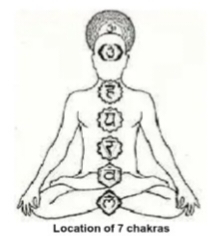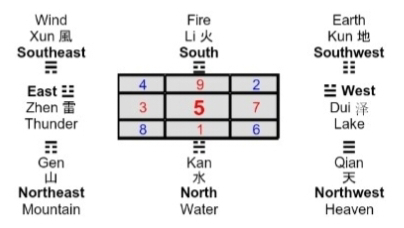लो शू अंकज्योतिष 02 | Ch. 00 Lo Shu: Definition, Nature and History
LO SHU MAGIC SQUARE
Lo Shu: Definition, Nature and History
Lo Shu Square (simplified Chinese:洛书; traditional Chinese: 洛書: literally: Luo (River) Book/Scroll) or the Nine Halls Diagram (simplified Chinese: 九宫图; traditional Chinese: 九宮圖), often in connection with the Ho Tu (河圖) figure and 8 trigrams, is the unique normal magic square of order three. Lo Shu is part of the legacy of the most ancient Chinese mathematical and divinatory (Yi Jing 易經) traditions, and is an important emblem in Feng Shui (風水, translate as "wind-water"), the art of geomancy concerned with the placement of objects in relation to the flow of qi (氣), 'natural energy'.
Actually, the first Chinese magic square is believed to have been created by Fuh-Hi, the mythical founder of Chinese civilization, who lived from 2858 to 2738 B.C. The scroll is a 3x3 magic square, where odd numbers are expressed as white dots, or yang symbols, and even numbers are expressed as black dots, or Yinsymbols. The odd numbers are supposed to be symbols of heaven, while even numbers are symbols of the earth.
四. 九. 三
五. 七. 八
二. – 六
4. 9. 2
3. 5. 7
8. 1. 6
In the Chinese Lo Shu square above, we have added colour here to make the distinction between the odd and even numbers stand out more clearly. In fact the yellow blobs should be white, being Yang symbols or emblems of heaven, and the red blobs should be black, being Yin symbols or emblems of earth.
Feng Shui is a form of qi divination. The retention or dissipation of qi is believed to affect the health, wealth, energy level, luck and many other aspects of the occupants of the space. Color, shape and the physical location of each item in a space affects the flow of qi by slowing it down, redirecting it or accelerating it, which directly affects the energy level of the occupants.
The qi (Chinese 氣, Japanese 気, Korean 氣, prāna in indian (sanskrit प्राण)) is an active principle forming part of any living thing; literal translation is "air", "breath" or "spirit". Qi is a didactic concept in many Chinese, Korean and Japanese martial arts.
Lo Shu is also connected to the Chakras and stimulate them. Chakra (derived from the Sanskrit cakram चक्र, wheel or disc. There are seven major chakras or energy centers, located within the subtle body, from the base of the spine to the top of the head, at major branchings of the human nervous system, beginning at the base of the spinal column and moving upward to the top of the skull and expressed life force energy (biophysical energy or prana of the human body). The seven major chakras are: Sahasrara, सहस्रार, Ajna, आज्ञा, Vishudda, विशद्ध, Anahata, अनाहत, Manipura, मणिपूर, Svadhishthana, स्वाधिष्ठान and Muladhara, मूलाधार. Moreover
Location of 7 chakras
placebo effect, there is a relationship between the positions and functions of the chakras and of the various organs of the endocrine system. The odd and even numbers alternate in the periphery of the Lo Shu
pattern, the 4 even numbers are at the four corners, and the 5 odd numbers form a cross in the center of the square. The sums in each of the 3 rows, in each of the 3 columns, and in both diagonals, are all 15 [fifteen is the number of days in each of the 24 cycles of the Chinese solar year; Xia Li (夏曆) or "Yin Calendar" - Gregorian calendar is the "Yang Calendar"]. This pattern, in a certain way, was used by the people in controlling the river. Since 5 is in the center cell, the sum of any two other cells that are directly through the 5 from each other is 10 (the gen number of the Ho Tu). The even numbers are Yin, the feminine principle. The odd numbers are Yang, the male principle. The symbolism of the square Lo Shu interprets 5 elements: earth, fire, metal, water, and wood. Like the Ho Tu, the Lo Shu square is used as a mandalic representation important in Feng Shui. For Chinese, the magic square symbolizes the harmony of the universe.
Bagua with name and nature (King Wen "Later Heaven" order)
Mathematics of Lo Shu Magic Square
From any magic square of order 3, by pivoting the square, you can get three other magic squares by rotation and four other magic squares by symmetry. These eight magic squares are considered as equivalent, but the center cell in a 3x3 normal magic square must be 5.
traveled through Egypt at that time (500 B.C.), was greatly influenced by the Egyptian philosophy on magic squares and numbers.
Lo Shu and Cardinal Points
Lo Shu is often drawn in the form of a 9-squares chart with each square representing a direction in the compass (see diagram below) namely North, South, East, West, Northeast, Northwest, Southeast, Southwest and the center (total 9 locations). The south is always represented by the number 9, and the north by the number 1.
Lo Shu is also connected to the Bagua and the eight trigrams. The Bagua (Chinese: 八卦; pinyin: bā guà; Wade-Giles: pa kua; literally "eight symbols") are eight diagrams used in Taoist cosmology to represent a range of interrelated concepts. Each consists of three lines, each either "broken" or "unbroken," representing a yin line or a yang line, respectively. Due to their tripartite structure, they are often referred to as "trigrams" in English. The eight trigrams are: Qian 天, "Heaven", Xun風,"Wind", Kan 水, "Water", Gen 山, "Mountain", Kun 地, "Earth", Zhen 雷, "Thunder", Li 火, "Fire" and Dui泽, "Lake".
It is important here to remind where does the Chinese Yin Yang symbols come from. The Chinese calendar divides the year cycle into 24 solar segments, including the Vemal Equinox, Autumnal Equinox, Summer Solstice and Winter Solstice, using the sunrise and Dipper positions; that is according to the sun positions on the tropical zodiac (Similar to western astrology). So, the proper origin of Yin Yang is the pattern of 24 solar segments.
Lo Shu Numbers and Their Meanings
The numbers in each square of the Lo Shu embrace a variety of meanings. Just to name a few:
Lo Shu Represent Represent Represent
No. Location colour Element
1 –> North White Water
2 –> Southwest Black Earth
3 –> East Pure Green Wood
4 –> Southeast Light Green Wood
5 –> Central Dull Yellow Earth
6 –> Northwest White Metal
7 –> West Red Metal
8 –> Northeast White Earth
9 –> South Purple Fire
The sum of each line (whether vertical, horizontal or diagonal) always equals fifteen. In other words, if you ignore the 5 in the center, you will notice that the number opposite each other all sums up to 10. (The River Map uses the difference while the Lo Shu Square uses the sum).
Similar to the River Map, the odd numbers (white dots) represents Yang and the even numbers (black dots) represents Yin. Apart from the 5 in the center, the Lo Shu numbers are arranged such that after every Yang number, a Yin number follows, and, after every Yin number comes a Yang number. In the I Ching, yin (陰) and yang (陽) are represented by broken and solid lines: yang is solid (-) and yin is broken (--). These are then combined into trigrams, which are more yang or more yin depending on the number of broken and solid lines (e.g. is heavily yang, while is heavily yin)
Some examples of Yin and Yang:
The Yin and Yang must be balanced. Yin and Yang are complementary and inseparable. It seems impossible to imagine one without the other. So if at any moment Yin is too strong Yang will be in the future and seek balance. For example, in summer, Yang peaked, immediately after, Yin began to grow while Yang declines gradually. So in winter, the Yin peaked and Yang its lowest point. The fact of reaching the highest point, whether the Yin or Yang, marks the beginning of their decline. The Yin and Yang can be found everywhere, even in the human body. For example the upper body is Yang while the bottom is Yin, a muscle contraction is Yang while a muscle at rest is Yin, even spirit can be Yin and Yang. Indeed, the mind in sleep state is Yang and spirit in a state of sleep is Yin.
Luo River: tributary of the Yellow River
The Luo River (Chinese: 洛河;) is a tributary of the Yellow River in China. It rises in the southeast flank of Huashan in Shaanxi province and flows east into Henan province, where it eventually joins the Yellow River at the city of Gongyi. The river's total length is 420 km. Although not a major river by most standards, it flows through an area of great archaeological significance in the early history of China. The Luo's main tributary is the YI River, which joins it at Yanshi. During the era of the Three Kingdoms, Cao Zhi wrote a famous poem to the goddess of the Luo River as an indirect expression of love for a deceased lover.
The Yellow River or Huang He / Hwang Ho (Chinese: 黃河) is the second-longest river in China (after the Yangtze River) and the sixth-longest in the world at 5,464 kilometers (3,398 mi). The Yellow River is called "the cradle of Chinese civilization", as its basin is the birthplace of the northem Chinese civilizations and was the most prosperous region in early Chinese history. Early Chinese literature refers to the Yellow River simply as He, or "River". The yellow color comes from loess suspended in the water.









Comments
Post a Comment